Relocation of moai facts for kids
The moai are giant stone statues from Easter Island, also known as Rapa Nui. For a long time, some of these amazing statues have been moved from the island. Since 1868, at least 12 moai have been taken from Easter Island and are now in other countries. These statues are often found in museums or private collections. They are moved for different reasons, like keeping them safe, studying them, or teaching people about them.
Sometimes, moai are returned to their home. For example, in 2006, one moai came back from Argentina after 80 years. In 2022, another moai returned from Santiago, Chile, after 150 years away.
Contents
Moai in Museums Around the World
Many moai statues are now kept in museums and collections outside of Easter Island. These statues help people worldwide learn about the history and culture of Rapa Nui. Here are some of the most famous moai found in different museums:
| Material | Height | Current Location | Country | Year Moved | Notes | Image |
|---|---|---|---|---|---|---|
| Basalt | 2.42 m | The British Museum, London | United Kingdom | 1868 | This moai, called Hoa Hakananai'a, was taken from Easter Island by a ship called HMS Topaze. It is a very famous statue. |  |
| Basalt | 1.56 m | The British Museum, London | United Kingdom | 1868 | This moai is known as Moai Hava. It is also part of the British Museum's collection. | 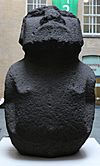 |
| Tuff | 1.85 m | Musée du quai Branly – Jacques Chirac, Paris | France | 1872 | This statue was first in another museum in Paris before moving to its current home. |  |
| Lapilli tuff | 2.24 m | National Museum of Natural History, Smithsonian Institution, Washington D.C. | United States | 1886 | This moai was taken from a special platform called Ahu O'Pepe on Easter Island. | 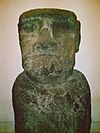 |
| Tuff | 1.194 m | National Museum of Natural History, Smithsonian Institution, Washington D.C. | United States | 1886 | This is another moai taken from Ahu O'Pepe. | |
| Tuff | 1.70 m | Pavillon des Sessions, Musée du Louvre, Paris | France | 1934-35 | This moai was given to the Chilean government after an expedition to Easter Island. | 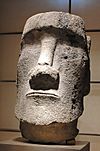 |
| Red scoria | 0.42 m | Pavillon des Sessions, Musée du Louvre, or the Musee de l'Homme, Paris | France | 1934-35 | This is a smaller moai made from red volcanic rock. | |
| Basalt | 3 m | Royal Museums of Art and History, Brussels | Belgium | 1934-35 | This large moai was also removed during an expedition. | 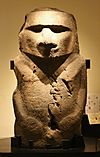 |
| Trachyte | 1.6 m | Otago Museum, Dunedin | New Zealand | 1929 | This moai traveled a long way. It was first moved to Tahiti before being sold to the Otago Museum. | 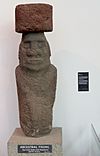 |
| Tuff | 2.81 m | Corporacion Museo de Arqueologia e Historia Francisco Fonck, Viña del Mar | Chile | This moai is located in a museum in Chile. |  |
|
| Basalt | Corporacion Museo de Arqueologia e Historia Francisco Fonck, Viña del Mar | Chile | This is another moai in the same museum in Chile. | |||
| Tuff | 2.94 m | Salón de la Polinesia, Museo arqueologico, La Serena | Chile | This moai was shown in Europe before being moved to a museum in Chile. | 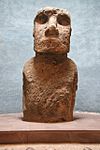 |
Are All Moai Real?
It can be very hard to know if a moai head is truly ancient or a modern fake. The rocks used to carve the moai are very old, so testing their age doesn't help. Scientists can only tell if the rock came from Easter Island or not. Deciding if a moai is real often depends on what experts think about the tools used to carve it.
The history of a moai, like where it came from and its story, is very important. Without a clear history, a moai might be suspected of being fake.
The "Henry" Moai
There is a moai head named "Henry" at the Forest Lawn Memorial Park, Glendale in California. The park's founder, Dr. Hubert Eaton, got it a long time ago. He said he bought it from fishermen on Easter Island who were using it as a boat weight. The park has no plans to test if "Henry" is real.
Suspected Fakes in Miami
In 2003, the Chilean government looked into two moai heads. These heads were part of a group of 15 Easter Island items for sale in a gallery in Miami. An archaeologist named Patricia Vargas looked at photos of the heads. She thought they might be nice art, but doubted they were 500 years old. She noticed that the cuts looked like they were made with modern machines, not old stone tools.
Moai Copies and Replicas
Because moai are so famous, many copies, or "replicas," have been made. These replicas allow people to see what the statues look like, even if they can't visit Easter Island.
In 1968, a real moai was taken from Rapa Nui to New York City. This was done to protest building a jet fuel station on Easter Island. A company later made a copy of this moai. They even claimed they could make 100 more copies.
You can find moai replicas in many places. Some are outside the Natural History Museum of Los Angeles County. Others are at the Auckland War Memorial Museum in New Zealand and the American Museum of Natural History in New York.
In Japan, there is a group of seven replica moai arranged like the real ones on Easter Island. They are in a park called Sun Messe Nichinan in Nichinan, Miyazaki Prefecture, on the island of Kyushu. These statues were built in 1996 for the park's opening.
In 2000, the Embassy of Chile in the United States gave a moai replica to the American University. This replica even had reconstructed eyes, showing what the original moai might have looked like.
Images for kids
See also
 In Spanish: Reubicación de moái para niños
In Spanish: Reubicación de moái para niños
- 2010 Easter Island moai referendum










